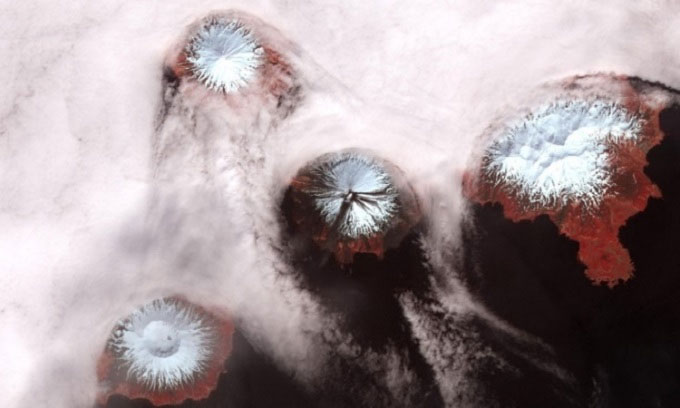Researchers have found substantial evidence revealing the existence of a supervolcano linked to seven other volcanoes in the Aleutian Islands.
The Aleutian Islands are a group of volcanic islands located off the southern coast of Alaska, home to 44 volcanoes. This archipelago has a unique crescent shape, extending across the northern Pacific Ocean. New research findings suggest that beneath this island chain lies a supervolcano, and the islands themselves may be remnants of a massive caldera, a depression resembling a large pan formed after a volcanic eruption.

The Aleutian Islands located in the northern Pacific. (Photo: NASA)
John Power, a geophysicist at the Alaska Volcano Observatory of the U.S. Geological Survey, stated that if this volcano had erupted in the past few thousand years, it could have posed a threat to civilizations worldwide. According to findings presented at the American Geophysical Union’s annual meeting on December 7, 2021, the Aleutian Islands may be remnants left after the supervolcano beneath erupted. Furthermore, this supervolcano could be connected to six volcanoes in the Aleutian Islands.
The volcanoes include: Herbert, Carlisle, Cleveland, Tana, Uliaga, and Kagamil, which may form a venting system along the edge of a much larger volcano, with Cleveland being the most active volcano in the group. Using a small seismometer, the research team recorded numerous micro-earthquakes around the islands, spreading northeastward. This is an indication of extremely strong volcanic activity.
Although the new research has not yet been confirmed, scientists have found compelling evidence. According to the study results, the summits of the volcanoes in the Aleutian Islands currently form a circular shape. Through mapping the seafloor topography, the research team discovered arc-shaped ridges and a depression 130 meters deep at the center of the circle beneath the water’s surface. Power noted that this discovery helps them understand why the Cleveland volcano is so active.
Power and his colleagues are still in the early stages of research. After gathering more evidence, they may be able to pinpoint current and future threats in the area to find ways to mitigate them.


















































